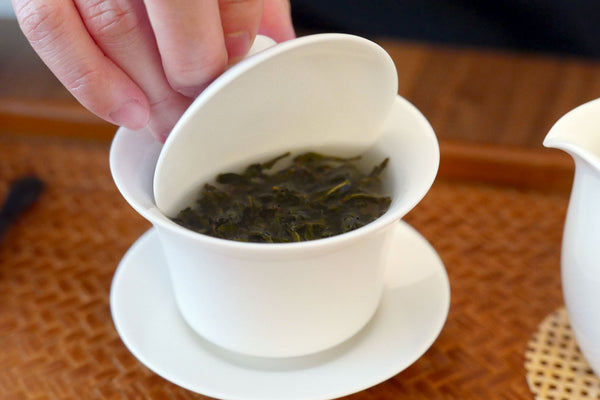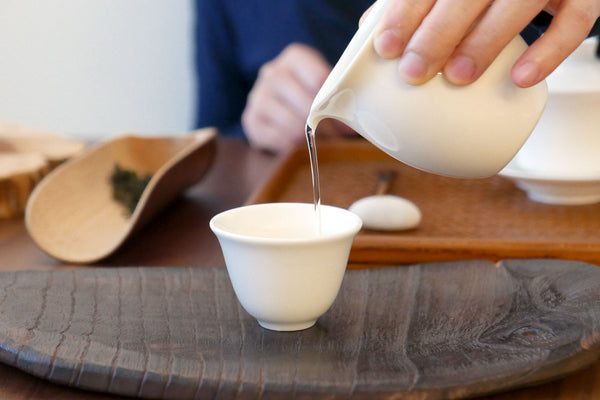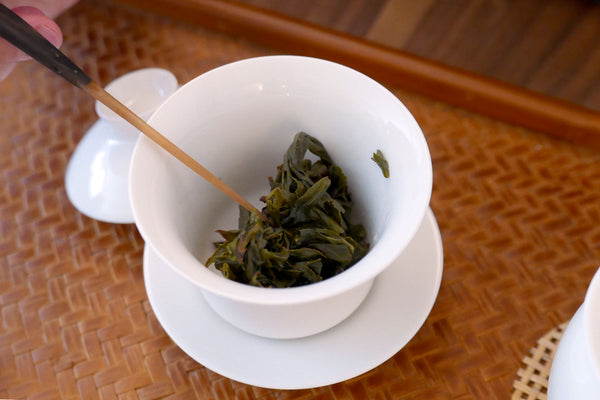Brew Tea in a Gaiwan
Gaiwan (蓋碗), a lidded bowl without a handle, is used to brew loose and (preferably) whole leaf teas. It is one of the most versatile teaware passed down since the Ming Dynasty of China.
Most gaiwans are made out of porcelain, a material suitable for brewing green, greener oolongs, and white teas, where the recommended brewing temperature is lower.
One benefit of using a gaiwan is that you can easily examine the tea leaves through each infusions, watching it unfurl and expand. gaiwan can be used as a tea brewing vessel as well as a drinking vessel by drinking directly from the bowl and strain the leaves with the lid, or one's front teeth.
In this guide we are brewing our Baozhong oolong tea, which has a twisted leaf shape. Twisted leaf tea (e.g., Baozhong or Jade Rouge) steeps faster than rolled leaf tea (e.g., Frozen Summit) so the brewing time should be closer to 1 minute instead of 2.
With the ratio we provided (4 grams of tea and 3.5 oz of water), we suggest 3 steepings using the same tea leaves, but feel free to adjust according to your preference. We recommend completing all your steepings within the day. Our suggested steeping time can vary by tea, though don't be shy to experiment. Try and see what works for your palate.
Step-by-Step Guide
Step 1: Weigh Tea Leaves
Weigh out 4 grams of oolong tea. Using a scale ensures you have the right amount of tea, regardless of the shape and size of the leaves.

Step 2: Rinse and Preheat the Gaiwan
Use hot water (195, 200, or 212 °F) to rinse your gaiwan. This is the same temperature you will use to brew the tea. Heating the teapot to your intended brewing temperature allows for more precise brewing. Please refer to individual tea pages for suggested brewing temperature by tea.

Step 3: Add Tea to the Gaiwan
Pour out the water from the gaiwan and add the loose-leaf tea to your gaiwan. The preheated teapot will help the tea leaves release their aroma and flavor more effectively.

Step 4: Add Water
Pour the water around the rim, this will swirl the tea leaves and make sure the tea leaves are wet evenly;
Generally, the water should be lower (~195 °F) for twisted tea leaves and higher (~212 °F) for tightly rolled tea leaves. Different temperatures help extract optimal flavors from the leaves.
Rinsing the tea is optional.

Step 5: Agitate the Tea Leaves
Make sure the tea leaves are wet evenly, using the gaiwan lid to stir the tea leaves.

Step 6: Let the Tea Brew
Brew for 1 minute. For tightly rolled tea leaves we prefer a longer
steeping time of 2 minutes. Use this time to heat up the pitcher and
teacups.

Step 7: Get Ready to Pour
To get ready to decant, tilt the gaiwan lid very gently until there is a sliver of opening to the rim of the bowl, then press down the lid with
the index finger to hold the lid in place. Then, hold each side of the
gaiwan with the thumb on one side and middle and ring fingers on the
other.

Step 8: Pour into a Pitcher
When the steeping time is up, pick up the gaiwan and pour the tea into a pitcher or a mug. Make sure all the liquid is drained from the gaiwan.
That way the tea doesn't over-brew and become bitter when you go back for subsequent steepings. To ensure there is no small tea residue in your brew, consider using a fine mesh tea strainer.

Step 9: Pour into your Cup
Pour the tea into your cups and enjoy!

Step 10: Re-steep the Tea
Re-steep the tea as many times as you fancy. We recommend three in total for this tea-to-water ratio. To re-steep, simply add more water. The second steep's suggested brewing time is the same as the first, and the third should be 1-2 minutes longer. Each steep will reveal subtle changes in flavor, allowing you to appreciate the depth and complexity of the tea.

